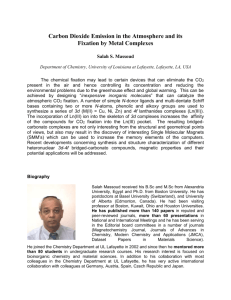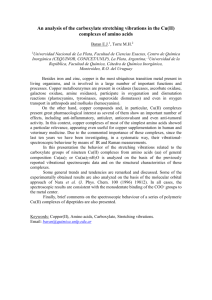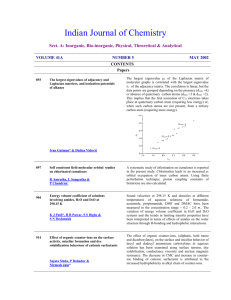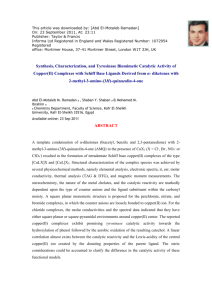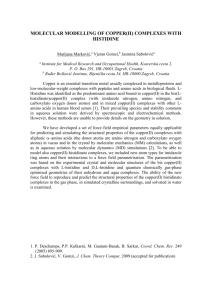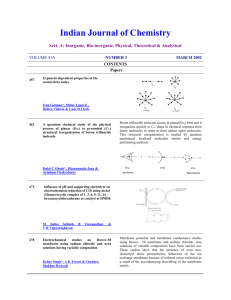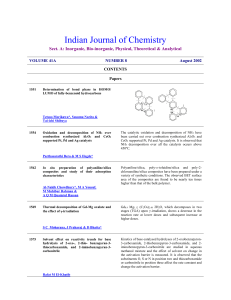July 2002 content
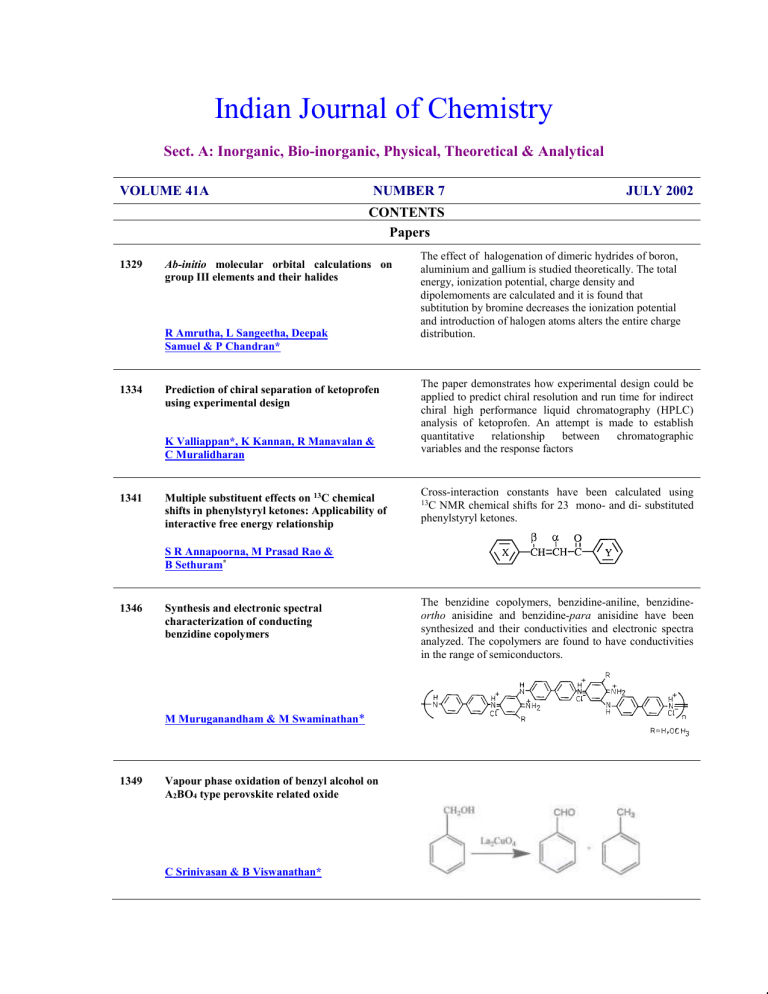
Indian Journal of Chemistry
Sect. A: Inorganic, Bio-inorganic, Physical, Theoretical & Analytical
VOLUME 41A
1329
1334
1341
NUMBER 7 JULY 2002
CONTENTS
Papers
Ab-initio molecular orbital calculations on group III elements and their halides
The effect of halogenation of dimeric hydrides of boron, aluminium and gallium is studied theoretically. The total energy, ionization potential, charge density and dipolemoments are calculated and it is found that subtitution by bromine decreases the ionization potential and introduction of halogen atoms alters the entire charge distribution.
R Amrutha, L Sangeetha, Deepak
Prediction of chiral separation of ketoprofen using experimental design
K Valliappan*, K Kannan, R Manavalan &
Multiple substituent effects on 13 C chemical shifts in phenylstyryl ketones: Applicability of interactive free energy relationship
The paper demonstrates how experimental design could be applied to predict chiral resolution and run time for indirect chiral high performance liquid chromatography (HPLC) analysis of ketoprofen. An attempt is made to establish quantitative relationship between chromatographic variables and the response factors
Cross-interaction constants have been calculated using
13 C NMR chemical shifts for 23 mono- and di- substituted phenylstyryl ketones.
1346
S R Annapoorna, M Prasad Rao &
Synthesis and electronic spectral characterization of conducting benzidine copolymers
The benzidine copolymers, benzidine-aniline, benzidineortho anisidine and benzidinepara anisidine have been synthesized and their conductivities and electronic spectra analyzed. The copolymers are found to have conductivities in the range of semiconductors.
M Muruganandham & M Swaminathan *
1349 Vapour phase oxidation of benzyl alcohol on
A
2
BO
4
type perovskite related oxide
1355
1363
1369
1374
1380
1385
Surface acidity and catalytic activity of mixed
Fe-Al and Cr-Al pillared montmorillonites
Synthesis and crystal structure of two extensively hydrogen bonded network of Cu(II)
Incorporation of iron and chromium oxide pillars along with Al
2
O
3 pillars within the interlayers of a montmorillonite clay has been investigated. Incorporation of Fe and Cr has changed the properties of Al pillared montmorillonite. Fe pillared systems have been found to be very good catalysts for benzoylation reaction.
Electron spin resonance, magnetic and superoxide dismutase activity of binuclear imidazolate bridged complexes
R N Patel*, K K Shukla, N Singh &
Isomeric mixed dioxolene 2-(arylazo)pyridine complexes of osmium(II): Synthesis, spectra and electrochemistry
Doyel Bose, Hafijur Rahaman, Jaya Banerjee,
Synthesis and reactivity of the copper (II) complexes of N-
-acetophenyl-Xsalicylaldimines (
= 4 or 3, X = H, 5-Br or
3-COOH ). Molecular structure of bis-( N-4acetophenyl- salicylaldiminato) copper(II)
Electron paramagnetic resonance, magnetic susceptibility and superoxide dismutase activity measurements of imidazolate bridged [(Salval)Cu-Im-Cu(Salval)]Na,
[(Salval)Cu-Im-Ni(Salval)]Na
Zn(Salval)]Na complexes, and
[where
[(Salval)Cu-Imsalval = salicyledenevalinate, im = imidazolate ion,] are described.
Rajib Lal De , Indrajit Banerjee ,
Subhadra Guha & Alok K Mukherjee
Synthesis and characterization of a chelating resin containing ONO donor tridentate Schiff base and its coordination compounds with copper(II), nickel(II), cobalt(II), iron(III), zinc(II), cadmium(II), manganese(II), molybdenum(VI), zirconium(IV) and uranium(VI)
A Syamal, D Kumar*, A K Singh, P K Gupta,
Polystyrene supported tridentate dibasic Schiff base
(PS-LH
2
) reacts with metal salts/coordination compounds to form compounds of the type PS-LM.xDMF, PS-LFeCl
2DMF and PS-LZr(OH)
2
.2DMF.
1391
1397
1402
Host-guest chromatographic behaviour of ketones in micellar paper chromatographic separation
Zhengsheng Fu*, Guoqin Li a , Aimei Yang,
Separation of 14 ketone compounds by paper chromatography using pure water micellar solution of hexadecyltrimethyl ammonium bromide and/or sodium dodecylsulphate as the mobile phase has been reported.
Suitability between the solute molecules (guest) and micelles (host) is the main driving force of chromatographic migration.
Immobilization of dithiooxamide in biopolymer and synthetic films for possible use in optical fibre copper probe
Notes
Dithiooxamide has been immobilized in a biopolymer matrix for the quantitative determination of Cu (II) by an optical fibre method. Immobilization of dithiooxamide in poly(methyl)methacrylate alone shows characteristics comparable to that of the biopolymer matrix .
Anupa Murugkar, Meena Karve, Subhash
Organization of amphiphiles, Part-II—Surface activity of polyoxyethylated alkyl phenols at air-water interface
Lingaraj Sahoo, Pramila K Misra*
1406
Olefin epoxidation catalyzed by novel nickel(II)-complexes containing tridentate
Schiff-base ligands
1410 Kinetics of dissociation of tris – (2, 2
– bipyridyl) and tris – (1, 10 – phenanthroline) iron (II) complexes in the presence of OH
–
in the water pools of CTAB reverse micelles
G Venkateswarlu, P Syamala, P V Subba Rao*
Kinetics of dissociation of tris (2, 2
-bipyridyl) and tris
(1, 10
– phenanthroline) complexes in the presence of OH
– ion in the water pools of CTAB reverse micelles in hexanechloroform mixtures has been studied. Increase in rate due to decrease in ionic strength predominates over the effect of increase in dielectric constant with increase in W.
1415
Synthesis and crystal structure of twodimensional network DB18-C-6 complex:
[Na(DB18-C-6)]
2
[Pt(SCN)
6
]
Tong Wang a,b , Jianmin Dou* a , Dacheng Li a ,
Daqi Wang a , Meimei Wu a & Peiju Zheng c
1417
Studies on cerium(III) complexes of piperidin-
4-ones
1421
Synthesis and characterization of acetylferrocenyl thiosemicarbazone derivatives of dichlorobis(cyclopentadienyl)hafnium(IV)
Soumitra Kumar Sengupta * , Om Prakash
Pandey, Alpana Bhatt, Vinita Srivastava &
1424 Synthesis and physico-chemical studies of manganese(II), nickel(II), cobalt(II), copper(II) and zinc(II) complexes of new 13-membered pentaazamacrocycles with N
4
donor sets
1428
Tahir Ali Khan*, Manzoor A Rather,
Ajax K Mohamed, Khan S. Islam &
Stability studies on 12-(5
’
-8
’
-hydroxy- quinolinic)methylene-1,4,7,10-tetraazacyclo tridecane-11,13-dione, 5-substituted 1,10phenanthroline-copper(II) with Cu 2+ or Co 2+ binuclear mixed-coordinated systems
1433
Xiaojun Zhao, Xuncheng Su a , Encui
Yang, Huakuan Lin*, Shourong Zhu,
Determination of zinc in high purity gallium by differential pulse anodic stripping voltammetry
A sensitive differential pulse anodic stripping voltammetric method is proposed for the determination of zinc in high purity gallium.
Suvarna Sounderajan, Avanti Singh &
1436 Spectrophotometric determination of iron in traces amount using 5-bromo-salicylaldehyde thiosemicarbazone
1438
A simple, sensitive and specific spectrophotometric method has been developed for the determination of iron(II) in aqueous dimethylformamide. The method has been employed successfully for the determination of Fe(II) in grape leaves, multivitamin capsules and human blood.
G Ramanjaneyulu, P Raveendra Reddy*,
V Krishna Reddy & T Sreenivasulu Reddy
Bismuth selective antimony(III) silicate inorganic ion–exchanger
Antimony(III) silicate has been synthesised, characterised, and its ion exchange properties have been ascertained.
Binary separations of Bi(III) from Pb(II), Cu(II), Zn(II) and
Hg(II) have been achieved from a column of the exchanger.
.
Authors for correspondence are indicated by (*)
Vol. 41A, July 2002, pp. 1329-1333
Ab-initio molecular orbital calculations on group III elements and their halides
R Amrutha, L Sangeetha, Deepak Samuel & P Chandran*
The effect of halogenation of dimeric hydrides of boron, aluminium and gallium is studied theoretically for the first time. Ab-initio molecular orbital theory at the RHF/6-31G* level has been used to investigate the physico-chemical properties of the dimers of hexahydrides and halogen substituted hexahydrides. The total energy, ionization potential, charge density and dipole moments are calculated.
Halogenation of the dimeric hydrides of Group IIIA elements brings out some interesting properties of the electronic structure of these molecules. From the calculation of ionization potential, it is seen that substitution by bromine decreases the ionization potential. The calculation also shows that whenever substitution of halogen occurs at the bridge position, the ionization potential is further lowered. From the charge density calculation, it is observed that the introduction of halogen (F, Cl or Br) atoms alters the entire charge distribution. Aluminium halides have stable structures and charge distribution compared to other halides of Group III elements. If the bridge atoms are not halogenated gallium behaves more or less like aluminium in all respects. A possibility of existence of dimers of gallium halides is explored. The dipole moments of the molecules are calculated and reported.
Vol. 41A, July 2002, pp. 1334-1340
Prediction of chiral separation of ketoprofen using experimental design
K Valliappan*, K Kannan, R Manavalan & C Muralidharan
The paper demonstrates how experimental design could be applied to predict chiral resolution and run time for indirect chiral high performance liquid chromatography (HPLC) analysis of ketoprofen. An attempt is made to establish quantitative relationship between chromatographic variables and the response factors (resolution and retention time). The effects of important chromatographic variables on chiral resolution and retention time have been highlighted by way of interaction studies. This technique enables optimal utilization of resources by avoiding trial and error approach. The study advocates that experimental design is a prospective tool to predict and optimize chromatographic conditions for chiral
HPLC analysis.
Vol. 41A, July 2002, pp. 1341-1345
Multiple substituent effects on 13 C chemical shifts in phenylstyryl ketones: Applicability of interactive free energy relationship .
S R Annapoorna, M Prasad Rao & B Sethuram *
13 C chemical shifts for 23 mono- and di-substituted phenyl styryl ketones have been determined. The shieldings and deshieldings are compared with previous results for other aromatic derivatives.
Correlations of the 13 C chemical shifts of vinyl carbons with Hammett
parameters was determined to provide a consistent picture of electronic effects transmitted through the carbon framework of the compounds studied. Slopes obtained from such Hammett's plots were termed as
, and using these '
' values applicability of interactive free energy relationship to chemical shift values has been tested. The cross- interaction constants q x
and q y
values for C-
were found to be -1.02 and -1.20 and for C-
are -
1.46 and -1.19.
Vol. 41A, July 2002, pp. 1346-1348
Synthesis and electronic spectral characterization of conducting benzidine copolymers
M Muruganandham & M Swaminathan*
The copolymers benzidine-aniline, benzidineoanisidine and benzidinepanisidine have been synthesised by chemical method. Their absorption and fluorescence spectra have been analysed. The copolymers are found to have conductivities in the range of semiconductors. In copolymers the longer wavelength absorption band of homopolymer is extended to infrared region.
Vol. 41A, July 2002, pp. 1349-1354
Vapour phase oxidation of benzyl alcohol on A
2
BO
4
type perovskite related oxide
C Srinivasan & B Viswanathan*
The substitution of strontium at lanthanum site in the sublattice of La
2
CuO
4
results in the formation of Cu 3+ species and formation of defects in the oxygen sublattice. As the strontium content increases the oxygen non-stoichiometry increases, whereas Cu 3+ content attains maximum at x = 0.3. As the oxygen non-stoichiometry (
) increases, the selectivity towards toluene increases, thus showing that formation of toluene depends on the oxygen non-stoichiometry. When the reaction is carried out in nitrogen atmosphere the LaCuO
4
system shows good selectivity towards toluene indicating the dependence of toluene selectivity on the atmosphere in which the reaction is carried out.
Vol. 41A, July 2002, pp. 1355-1362
Surface acidity and catalytic activity of mixed Fe-Al and
Cr-Al pillared montmorillonites
S Sugunan* & K S Rahna
The incorporation of transition metal oxide pillars such as those of iron and chromium along with Al2O3 pillars within the interlayers of a montmorillonite clay is investigated. The surface acidity of these catalysts has been evaluated for the first time employing the equilibrium adsorption of an electron donor, perylene, and the results are compared with those obtained by temperature programmed desorption of ammonia. The principle is based on the ability of a catalyst surface site to accept a single electron from an electron donor like perylene to form charge transfer complexes and the amount of adsorbed species is measured quantitatively by UV-Vis spectroscopy. Finally, an attempt has been made to correlate the acidity determined by the two independent methods and the catalytic activity of present systems in the benzoylation of toluene with benzoyl chloride. Incorporation of Fe and Cr has changed the properties of Al pillared montmorillonite. Fe pillared systems have been found to be very good catalysts for benzoylation reaction.
Vol. 41A, July 2002, pp. 1363-1368
Synthesis and crystal structure of two extensively hydrogen bonded network of Cu(II)
Sudipta Dalai, Partha Sarathi Mukherjee + , Steven Geib & Nirmalendu Ray Chaudhuri
Two new Cu(II) coordination polymers of higher dimensionality, [Cu(L1)2](L2), [L1= N-(2hydroxyethyl)ethylenediamine, L2= fumarate dianion], (1) and [Cu(L3)2(H2O)2](L4), [L3= 1-(2aminoethyl)pyrrolidine, L4= squarate dianion], (2), have been synthesized and characterized by X-ray single crystal analysis. Complexes (1) and (2) form 3D and 2D network respectively through extensive hydrogen bonding.
Vol. 41A, July 2002, pp. 1369-1373
Electron spin resonance, magnetic and superoxide dismutase activity of binuclear imidazolate bridged complexes
R N Patel*, K K Shukla, N Singh & K B Pandeya +
Electron paramagnetic resonance, magnetic susceptibility and superoxide dismutase (SOD) activity measurements of imidazolate bridged [(Salval)Cu-Im-Cu(Salval)]Na, [(Salval)Cu-Im-Ni(Salval)]Na and
[(Salval)Cu-Im-Zn(Salval)]Na complexes, [where salval = salicyledenevalinate, im = imidazolate ion,] are described. Related mononuclear copper(II) compelxes are also synthesized. The p H-dependent EPR and electronic spectroscopic studies of frozen 50% aqueous DMSO solution of homo- and heterobinuclear complexes have been found to be stable over the wide p H range.
Vol. 41A, July 2002, pp. 1374-1379
Isomeric mixed dioxolene 2-(arylazo)pyridine complexes of osmium(II):
Synthesis, spectra and electrochemistry
Doyel Bose, Hafijur Rahaman, Jaya Banerjee, Naba Kumar Mondal & Barindra Kumar Ghosh*
The complexes blue-violet ( 3 ) and red-violet ( 4 ) isomers of [OsX
2
L
2
] [X = Cl or Br; L ( 2 ) = 2-
(phenylazo)pyridine (L 1 ) and 2-( m -tolylazo)pyridine (L 2 )] react smoothly with catechol and its substituted derivative [H
2
Q; ( 1 )] in boiling aqueous ethanol affording mixed tris complexes of the type [OsQL
2
] [( 5 ) and ( 6 ), respectively]. The new complexes have been characterized by physicochemical, spectroscopic and magnetic methods. From 1 H NMR spectra (taking
Me
of L 2 as diagnostic probe), the stereoretentivity of the reactions is proposed. The diamagnetic complexes display a number of spin-allowed and spinforbidden charge-transfer transitions in the 1200-200 nm range. Both ( 5 ) and ( 6 ) are electroactive and display six voltammetric responses – two oxidations and four reductions. EPR study of the coulometrically generated one-electron oxidation product suggests the involvement of semiquinone radical formation.
Vol. 41A, July 2002, pp. 1380-1384
Synthesis and reactivity of the copper (II) complexes of
N-
-
acetophenyl
-
X-salicylaldimines (
=
4 or 3
,
X
=
H, 5-Br or3-COOH ).
Molecular structure of
bis-( N- 4-acetophenyl-salicylaldiminato
)
copper(II)
Rajib Lal De , Indrajit Banerjee , Subhadra Guha + & Alok K Mukherjee +
The copper (II) complexes of the Schiff bases, N-
-acetophenyl-X-salicylaldimines (
= 4 or 3, X
= H, 5-Br, 3-COOH) have been synthesised and characterised by UV-visible, IR, MS, ESR spectroscopy and magnetic suceptibility measurements. The solid state structure of Cu(SACPN x
)
2
( I ) determined by single-crystal X-ray diffraction reveals a distorted square-planar metal coordination involving two imine
N- and two deprotonated phenolate O atoms of two bidentate Schiff ligands in trans - arrangement. Both the Schiff bases and their copper (II) complexes undergo facile transamination reactions.
Vol. 41A, July 2002, pp. 1385-1390
Synthesis and characterization of a chelating resin containing ONO donor tridentate Schiff base and its coordination compounds with copper(II), nickel(II), cobalt(II), iron(III), zinc(II), cadmium(II), manganese(II), molybdenum(VI), zirconium(IV) and uranium(VI)
A Syamal, D Kumar*, A K Singh, P K Gupta, Jaipal & L K Sharma
New polystyrene supported coordination compounds have been synthesized by the reaction of metal salt/metal coordination compound with the polystyrene supported Schiff base (PS–LH2) (obtained by the reaction of chloromethylated polystyrene, 3-formylsalicylic acid and ethanolamine). The compounds have the formulae: PS–LCu
DMF, PS–LNi
3DMF, PS–LCo
3DMF, PS–LFeCl
2DMF, PS–
LZn
DMF, PS–LCd
DMF, PS–LMn
3DMF, PS–LMoO2
DMF, PS–LZr(OH)2
2DMF and PS–
LUO2
DMF (DMF = dimethylformamide). The compounds have been characterized by elemental analyses, IR, electronic, ESR spectral and magnetic susceptibility measurements. The Cu(II), Ni(II),
Co(II), Fe(III) and Mn(II) compounds are paramagnetic while the Zn(II), Cd(II), Zr(IV), Mo(VI) and
U(VI) compounds are diamagnetic. The magnetic and ESR data indicate the magnetically dilute nature of the metal centres. The shifts of the
(C=N)(azomethine),
(C–O)(phenolic) and
(C–O)(alcoholic) stretches have been monitored to find out the donor sites of PS–LH2. A square planar structure for PS–
LCu
DMF; a tetrahedral structure for PS–LZn
DMF and PS–LCd
LNi
3DMF, PS–LCo
3DMF, PS–LFeCl
2DMF, PS–LMn
3DMF, PS–LMoO2
DMF and PS–LUO2
DMF have been suggested for the compounds. PS–LZr(OH)2
DMF; an octahedral structure for PS–
2DMF is pentagonal bipyramidal.
Vol. 41A, July 2002, pp. 1391-1396
Host-guest chromatographic behaviour of ketones in micellar paper chromatographic separation
Zhengsheng Fu*, Guoqin Li a , Aimei Yang, Weidong Liang b & Zhiguo Wang
Separation of 14 ketone compounds by paper chromatography using pure water micellar solution of hexadecyltrimethyl ammonium bromide (CTAB) and/or sodium dodecylsulphate (SDS) as the mobile phase have been reported. Based on the calculated molecular structural factors (e.g. length, width and height, etc.) and the cavities of micelles, the ketones can be divided into three molecular groups. Each group has its own characteristics and all the groups show the suitability between the solute molecules (guest) and micelles (host). The suitability is the main driving force of chromatographic migration and reveals the relationship between solutes’ molecular structures and the cavities of surfactants.
Furthermore, the suitability can be directly used to explore molecular structure such as sizes and geometry.
Notes
Vol. 41A, July 2002, pp. 1397-1401
Immobilization of dithiooxamide in biopolymer and synthetic films for possible use in optical fibre copper probe
Anupa Murugkar, Meena Karve & Subhash Padhye* and
R Narayanaswamy
Dithiooxamide (DTO), a metallochromogenic reagent, has been immobilized in a composite biopolymer matrix for the quantitative determination of Cu(II) by an optical fibre method. The suitability of the biopolymer matrix for immobilization purposes has been determined from its stability in acid and basic media and absence of leaching of the immobilized DTO and its copper complex. Immobilization of DTO in poly(methyl)methacrylate (PMMA) alone shows characteristics comparable to that of the biopolymer matrix, while polyvinyl alcohol (PVA), polyvinyl chloride
(PVC) and Nafion
membranes are found to be unsuitable. A linear response is obtained for Cu(II) concentrations between 1 to 5 ppm.
Vol. 41A, July 2002, pp. 1402-1405
Organization of amphiphiles,
Part-II—Surface activity of polyoxyethylated alkyl phenols at air-water interface
Lingaraj Sahoo &Pramila K Misra* and
P Somasundaran
The surface properties of a series of polyoxyethylated alkyl phenols 1a [C8H17-O(CH2CH2O)n-H, n = 10,
30] and 1b [C9H19-O(CH2CH2O)n-H, n= 10, 15, 20, 40] have been studied through surface tension measurement by
Wilhelmy plate method. The surface pressure values calculated from surface tension data have been fitted to Gibbs adsorption equation and the standard free energies of micellization and adsorption at air water-interface have been calculated. The minimum area per surfactant molecule and critical micellar concentrtion reveal that both steric constraints and hydrophobicity of the surfactant play a major role in micelle formation
.
Vol. 41A, July 2002, pp. 1406-1409
Olefin epoxidation catalyzed by novel nickel(II)complexes containing tridentate Schiff-base ligands
Debabrata Chatterjee* &Sanghamitra Mukherjee
Novel Schiff base complexes of nickel(II), [NiL1(H
2
O)] ( 1 ) {H
2
L
1
= N-(2-hydroxyphenyl)salicylaldiimine},
[NiL
2
(H2O)] ( 2 ) {Happ = N-(2-hydroxyphenyl) pyridine-2-carboxaldimine}, [NiL
3
(H
2
O)] (3) {N-(2carboxyphenyl)salicylaldiimine}and [NiL
4
(H2O)] ( 4 ) {N-(2-carboxyphenyl)pyridine-2-carboxaldi-mine} have been prepared and characterized by physico-chemical analysis. Complexes 1-4 are found to be active in catalyzing hydrocarbon oxidation in the presence of single oxygen atom donors. Efficiency of NiL complex towards catalysing epoxidation of olefins in the presence of various oxidants viz. NaOCl, KHSO
5
, H
2
O
2
, pyridine N-oxide (PyO), t -
BuOOH, etc., has been examined and it is found that the complexes 1-4 can effectively catalyze the epoxidation of olefins in the presence of NaOCl and KHSO
5
.
Vol. 41A, July 2002, pp. 1410-1414
Kinetics of dissociation of tris – (2, 2
– bipyridyl) and tris
– (1, 10 – phenanthroline) iron (II) complexes in the presence of OH
–
in the water pools of CTAB reverse micelles
G Venkateswarlu, P Syamala, P V Subba Rao* &K Ramakrishna
The kinetic study of the dissociation of tris (2, 2
-bipyridyl) and tris (1, 10 –phenanthroline) complexes in the presence of OH– ion in the water pools of CTAB reverse micelles in hexane-chloroform mixtures has been carried out. The former reaction has OH– independent and dependent paths whereas the latter has only OH– dependent path. The special property of the water pool, the lower polarity (than water), has effect on kinetics. The increase in molar ratios of
[water]/[surfactant] (= W) results in decrease in rate of the OH– independent path. on the other hand an increase in W results in increase in rate of OH– dependent path. The kinetic analysis of this effect has been carried out considering the effects of dielectric constant and ionic strength of water pool on the rates. The results show that increase in rate due to decrease in ionic strength predominates over the effect of increase in dielectric constant with increase in W. The dissociation of tris(1, 10-phenanthroline) iron(II) does not have OH– independent path and the effect of W on this reaction is identical with that of OH– dependent path of the former reaction.
Vol. 41A, July 2002, pp. 1415-1416
Synthesis and crystal structure of two-dimensional network
DB18-C-6 complex: [Na(DB18-C-6)]
2
[Pt(SCN)
6
]
Tong Wang, Jianmin Dou* a , Dacheng Li, Daqi Wang, Meimei Wu & Peiju Zheng
A novel dibenzo-18-crown-6 (DB18-C-6) complex [Na(DB18-C-6)]
2
[Pt(SCN)
6
] (1) has been synthesized and characterized by elemental analysis, IR spectrum and X-ray diffraction analysis. The complex belongs to triclinic, space group P-1 with cell dimensions: a = 1.2500(3), b = 1.2825(3), c =
1.9342(4) nm,
= 106.82(3),
= 102.51(3),
= 103.04(3)
, V = 2.7562 nm 3 , Z = 2, D calcd
= 1.579 g/cm 3 ,
F(000) = 1316, R
1
= 0.0364, wR
2
= 0.0771. The complex shows a two-dimensional network structure of
[Na(DB18-C-6)] + complex cations and [Pt(SCN)
6
] 2- complex anion bridged by Na-N interactions between adjacent [Na(DB18-C-6)] + and [Pt(SCN)
6
] 2 units.
Vol. 41A, July 2002, pp. 1417-1420
Studies on cerium(III) complexes of piperidin-4-ones
Kuppusamy Selvaraj* & Chinniagounder Theivarasu
Ten new cerium(III) nitrate complexes of the general formula [Ce(L)
2
(NO
3
)
2
(H
2
O)
2
]NO
3
with variously substituted
2,6-diphenylpiperidin-4-ones (L 1 )-(L 10 ) have been prepared in ethanol and characterized by elemental analysis, molecular weights, molar conductance, magnetic and thermal studies and infrared and NMR spectra. Molar conductance data and van’t Hoff factor (i = 2) show that these complexes are 1:1 electrolytes. The IR spectral data reveal the participation of water molecules and thermal studies confirm the presence of two coordinated water molecules. IR spectra, elemental analyses and molar conductance data suggest that these complexes contain one ionic and two bidentate nitrate groups. Although piperidin-4-ones have two coordinating sites, namely the ring nitrogen and carbonyl group, IR and NMR spectral evidences are in favour of the ring nitrogen as the coordinating group and not the carbonyl group, thereby indicating that these ligands are monodendate. All the observations lead to the conclusion that cerium has a coordination number of eight in these complexes.
Vol. 41A, July 2002, pp. 1421-1423
Synthesis and characterization of acetylferrocenyl thiosemicarbazone derivatives of dichlorobis(cyclopentadienyl)hafnium(IV)
Soumitra Kumar Sengupta * , Om Prakash Pandey, Alpana Bhatt, Vinita Srivastava & Kushal Nath Mishra
The reactions of Cp2HfCl2 with thiosemicarbazones (LH) derived from acetylferrocene and substituted thiosemicarbazide (phenyl/4-chlorophenyl/4-nitrophenyl/4-methylphenyl thiosemi-carbazide) in various stoichiometric ratios have been studied and the complexes of the type [Cp2HfCl(L)] are obtained. Tentative structural conclusions are
drawn for the reaction products based upon elemental analyses, electrical conductance, magnetic moment and spectral data (UV-Vis, IR, 1H NMR and 13C NMR).
Vol. 41A, July 2002, pp. 1424-1427
Synthesis and physico-chemical studies of manganese(II), nickel(II), cobalt(II), copper(II) and zinc(II) complexes of new 13-membered pentaazamacrocycles with
N
4
donor sets
Tahir Ali Khan*, Manzoor A Rather, Ajax & K Mohamed, Khan S. Islam and Nafees Jahan
A new series of 13-membered pentaazamacrocyclic complexes of the type, [MLX2], [where M = Mn(II), Ni(II),
Co(II), Cu(II) and Zn(II); X=Cl or NO3], incorporating an N4 donor set has been prepared via the template condensation of triethylenetetraamine, formaldehyde and 4,4'-diaminobiphenyl in 1:2:1 molar ratio in the presence of the metal salt. The complexes have been characterized by physico-chemical and spectroscopic measurements as nonionic, octahedral species .
Vol. 41A, July 2002, pp. 1428-1432
Stability studies on 12-(5
’
-8
’
-hydroxyquinolinic)methylene-
1,4,7,10-tetraazacyclo tridecane-11,13-dione, 5-substituted
1,10-phenanthroline-copper(II) with Cu 2+ or Co 2+ binuclear mixed-coordinated systems
Xiaojun Zhao, Xuncheng Su, Encui Yang, Huakuan Lin*, Shourong Zhu, Hongwei Sun &
Yunti Chen
C
-functionalized dioxotetraamine ligands L have been designed and synthesized through simple methods, and characterized by elemental analysis, IR, mass spectra and 1H NMR. The ligand contains two independent chelating groups. At 25.0
0.1
C, I=0.1mol
dm-3 NaNO3, pH titration has been performed to study the stability properties of L-
5-R-5,10-phenanthroline-Cu(II) with proton, copper(II) and cobalt(II). The ternary complexes have been shown to possess interesting properties due to the involvement of three chelating groups, 5-substituted-1,10-phenanthroline, 8hydroxyquinolin and dioxotetraamine. In addition, potentiometric titrations have been performed to study the protonation of L-5-R-1, 10–phenanthroline-Cu(II) (R=CH3,H,Cl,NO2) and their stability properties with copper(II) and cobalt(II). The results show that for Cu 2+ and Co 2+ , 8-hydroxyquinoline is a strong chelating reagent than dioxytetraamine macrocycles. Using molecular mechanics (MM + ) calculation, the stability of ternary mixed system on
Co(II)-L-5-substituted-1,10-phenanthroline-Cu(II) and Cu(II)-L-5-substituted–1,10-phenanthrolineCu(II) have been studied and compared with the coordination ability for different coordination sites and for different metal ions (Co(II) and Cu(II)) at the same coordination site. The results obtained from calculation agree with the experimental results
.
Vol. 41A, July 2002, pp. 1433-1435
Determination of zinc in high purity gallium by differential pulse anodic stripping voltammetry
Suvarna Sounderajan, Avanti Singh & M M Palrecha*
A simple voltammetric method has been described for the determination of trace amount of zinc in high purity gallium metal. Differential pulse anodic stripping voltammetry (DPASV), permits a direct determination of zinc
without preliminary enrichment or separation process. Zinc can be determined to levels of 1-2
g g-1, with relative standard deviation of about 14% in
150 mg sample of gallium.The detection limit was restricted by the amount of zinc present in the reagent blank solution.The possible interferences due to Pb, Cd, Cu, Ni, Mn, Fe, Tl, Co, Ti, V, Al etc have also been evaluated
Vol. 41A, July 2002, pp. 1436-1437
Spectrophotometric determination of iron in traces amount using 5-bromo-salicylaldehyde thiosemicarbazone
G Ramanjaneyulu, P Raveendra Reddy*, V Krishna Reddy & T Sreenivasulu Reddy
A simple, sensitive and specific spectrophotometric method has been developed for the determination of iron(II) in aqueous dimethylformamide (DMF). The metal ion reacts with 5-bromosalicylaldehyde thiosemicarbazone
(5-BSAT) forming a green coloured complex in the pH range 5.0-6.0. The complex shows maximum absorption at 385 nm. Beer’s law is obeyed in the range 0.28-5.60 µg/ml. The molar absorptivity and Sandell’s sensitivity are found to be
1.72
104 l mol-1 cm-1 and 0.032 µg cm-2, respectively. The method has been employed successfully for the determination of Fe(II) in grape leaves, multivitamin capsules and human blood.
Vol. 41A, July 2002, pp. 1438-1440
Bismuth selective antimony(III) silicate inorganic ion– exchanger
C Reetha 1
,
K K Aravindakshan 2* & C Janardanan 1*
Antimony(III) silicate has been synthesised, characterised, and its ion exchange properties have been ascertained.
The exchanger is stable in water, alcohol, acetic acid, 1.0M HCl, 1.0M HNO3 and in aqueous solutions of LiCl, KCl,
MgCl2, CaCl2 and BaCl2. Its exchange capacities for various alkali and alkaline earth metal ions have been determined. Also distribution coefficients for various metal ions, effect of electrolyte concentration and temperature and pH on ion exchange capacity have been studied. The molar ratio, found from chemical analysist as 1:1, suggest
Sb2O3 2SiO2 nH2O as the empirical formula for the exchanger. Binary separations of Bi(III) from Pb(II), Cu(II),
Zn(II) and Hg(II) have been achieved from a column of the exchanger

